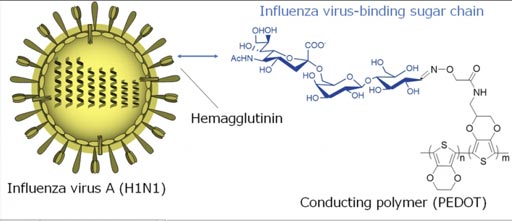Biosensor Technology Enables Rapid Detection of Flu Virus
By LabMedica International staff writers
Posted on 12 Jun 2017
A research team has developed a voltage-sensor for early detection of influenza virus A (H1N1) that is almost 100 times more sensitive than conventional tests, and can distinguish between human and avian strains.Posted on 12 Jun 2017
Researchers at Tokyo Medical and Dental University (TMDU; Tokyo, Japan) developed the sensor for early detection of even very low virus concentrations. Such early-stage diagnosis is crucial for averting a potential pandemic outbreak, as antiviral medication must be administered in a timely fashion. Conventional tests for detecting the flu virus are often slow and expensive, and can miss early viral infections. In contrast, the new biosensor measures tiny changes in voltage in an electrically conductive polymer to quickly detect virus concentrations almost 100 times smaller than the limit of currently available kits.

Image: Human influenza virus recognition by sugar-modified conducting polymers. A new conducting polymer was developed for detecting specific interaction of trisaccharide with hemagglutinin in the envelope of the human influenza A virus (H1N1) by electrical manners (Photo courtesy of the Tokyo Medical and Dental University).
Conductive polymers are a class of carbon-based molecules that conduct electricity, but can also be used in biological environments. Biomolecules can be easily attached to the polymers, allowing them to bind with specific targets. In this study, poly(3,4-ethylenedioxythiophene) (PEDOT) was modified with a functional group that binds with the H1N1 human influenza virus, but not avian influenza strains.
“Conducting polymers have several advantages over inorganic counterparts,” explained corresponding author Yuji Miyahara, “These include the ability to conduct both electrical and ionic carriers, mechanical flexibility, low cytotoxicity, low-cost production by casting or printing, and tunable properties via chemical synthesis or doping.”
To construct the biosensor, the polymer film was placed between two electrodes. When a solution containing H1N1, which carries a tiny positive charge on its exterior shell, was added, some of the viruses stuck to the polymer and increased the voltage measured by the electrodes. This electrical method allows the sensor to detect the presence of miniscule amounts of the virus. Viral loads are often measured in hemagglutination units (HAU). The new sensor can detect viral concentrations as small as 0.013 HAU. By comparison, commercially available kits that use immunochromatographic tests only work for concentrations greater than about 1.13 HAU.
“The device is a good candidate for wearable monitoring and point-of-care testing,” added study coauthor Shoji Yamaoka.
The study, by Hai W et al, was published April 5, 2017, in the journal ACS Applied Materials & Interfaces.
Related Links:
Tokyo Medical and Dental University













